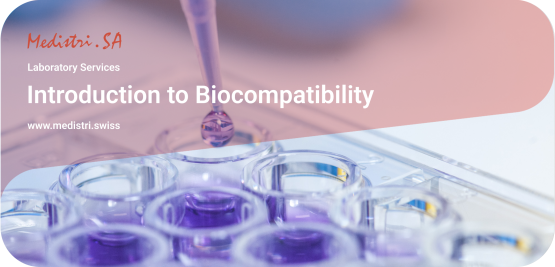(Download: Introduction to Biocompatibility in PDF by Medistri)
In the medical device industry, biocompatibility evaluations are performed to assess the risk of harm to patients or users resulting from device contact with living tissue and bodily fluids. Standards such as ISO 10993 and USP Class VI provide a framework for evaluating the risk profile of a medical device, based on the nature of body contact and the duration of contact.
👉 ISO 10993 is a widely recognized standard for evaluating the biocompatibility of devices that come into direct or indirect contact with the human body. This standard uses a risk-based approach, which is defined in ISO 14971 as the combination of the probability of occurrence of harm and the severity of that harm. In this approach, the risk assessment considers the likelihood and consequences of a particular risk and adapts the Original Equipment Manufacturers (OEM) quality management activities accordingly.
In addition to device-specific factors, such as intended use, the device risk assessment is driven in part by the materials used in the device. A material supplier may be able to provide biocompatibility test results of materials used in the device, which can simplify the testing required on the device. The information of materials biocompatibility can help the medical device manufacturer to determine the level of risk associated with the device and the appropriate testing and validation to be performed.
✔ In order to ensure optimal performance and patient safety, it is crucial to thoroughly evaluate and understand the biocompatibility and biostability properties of the materials under consideration. The selection of appropriate materials for use in medical devices is a complex process that requires:
-
Extensive testing
-
Quality control
-
Adherence to compliance regulations
When evaluating potential materials, Medical Device Manufacturers should consider the following factors:
-
The biocompatibility of the materials
-
The biostability of the materials
-
The performance of the design-specific features in a biological environment
👉 Biocompatibility is defined as the ability of a material to perform with an appropriate host response in a specific application
👉 Biostability is defined as the ability of the polymer to maintain its physical and mechanical properties in a biological environment over an extended period of time.
Both biocompatibility and biostability are crucial factors to consider when selecting materials. It is necessary to consider the biocompatibility and biostability performance of the material in relation to the intended biological environment and exposure time for the device. Failure to do so can lead and is not limited to:
-
Unwanted patient responses
-
Premature degradation and loss of key device-properties that could result in device failure
In order to ensure the development of safe and effective medical devices, medical device manufacturer must:
-
Seek guidance from a trusted laboratory like Medistri on material selection.
-
Work with Medistri to consider the specific biocompatibility and biostability requirements of the finished device.
-
Work with Medistri to consider developing materials that have enhanced biocompatibility and biostability properties which can result in more effective medical devices compared to commercially available materials.
ISO 10993 and USP Class VI provide a framework for evaluating the biocompatibility of medical devices, which is crucial to ensure patient safety. These standards describe a range of endpoint tests to assess the biocompatibility of devices that come into contact with the human body. Some of these tests include:
-
Cytotoxicity: Evaluation of the potential toxicity of a device to living cells.
-
Sensitization: Assessment of the potential for a device to cause a sensitizing effect upon repeated exposure.
-
Irritation: Evaluation of the potential for a device to cause a localized inflammatory response.
-
Acute Systemic Toxicity: Evaluation of the potential for a device to cause short-term toxic effects.
-
Pyrogenicity: Assessment of the potential for a device to cause fever or other symptoms resulting from the presence of pyrogens (substances that can cause fever).
-
Subacute and Subchronic Toxicity: Evaluation of the potential for a device to cause medium-term and long-term toxic effects.
-
Genotoxicity: Assessment of the potential for a device to cause genetic damage or mutations.
-
Implantation: Evaluation of the potential for a device to cause local effects after contact with tissue.
-
Hemocompatibility: Evaluation of the potential for a device to interact with blood.
-
Chronic Toxicity: Assessment of the potential for a device to cause very long-term toxic effects.
-
Carcinogenicity: Evaluation of the potential for a device to cause cancer or tumors.
-
Reproductive and Developmental Toxicity: Evaluation of the potential for a device to impact reproductive function or embryonic development.
Medistri’s Laboratory provides the tests required to verify biocompatibility differ by type of device (surface contact, implantable), type of contact (skin, mucous membrane, wound area, tissue, bone, dentine, bloodstream, blood…), the contact time (limited, prolonged or permanent) and the historical data existing on the material used.
🎯 To learn more about our Biocompatibility Testing according to ISO 10993 services, visit on our website at www.medistri.swiss or directly contact our team at contact@medistri.swiss.
— The Medistri Team
#Medistri
Medistri’s Biocompatibility testing Services: https://www.medistri.swiss/biocompatibility-testing
